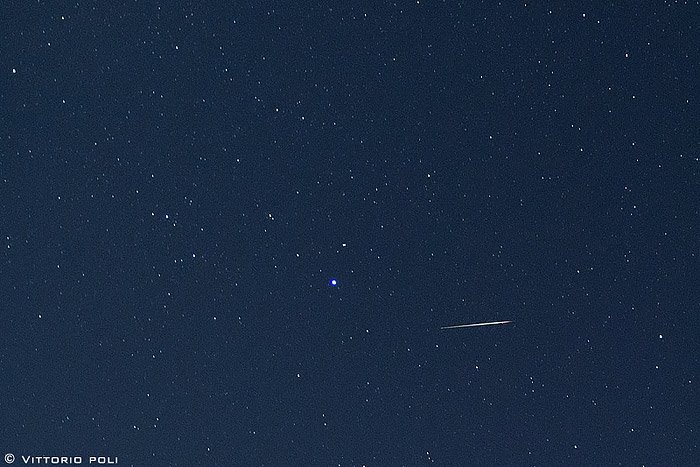The International Meteor Organization – consisting of sky watchers from around the world – has reported there was indeed an outburst of Draconid meteors on October 8, 2011, as predicted earlier this year by Canadian astronomer Paul Wiegert. That outburst came despite a bright waxing gibbous moon, which some thought might spoil the show. Preliminary counts suggest a peak rate of 660 meteors per hour at 20:10 UT (3:10 pm CDT).
Astronomer predicts dramatic Draconid meteor shower for October 8, 2011
Report your Draconid meteor observations here
That’s a couple of hours later than predicted, but still an impressive and helpful prediction by Dr. Wiegert, whose work alerted many around the world to this wonderful event.

Some people saw a good show, and others only a few meteors. Some saw the meteors in conjunction with a display of the beautiful aurora or northern lights. As always, those with clear skies who watched in country locations had the best view. We began hearing late in the afternoon on October 8 on the EarthSky Facebook page from people who were seeing meteors in the Draconid shower. We heard mostly from people in Europe, but Africa and the Middle East were also favored in the prediction. We heard scattered reports of bright meteors in the United States before and after the shower’s peak.
Ole Holst said:
… over 30 meteors in half an hour here in Denmark :)
Håkan Ståhle said:
… not a shower . . a few drops though . . south Sweden.
Roberta Strazzabosco said:
… 37 at the moment.. in Asiago Italy :)
Nicola Tennant Brown in Mallorca said:
… sky is busy!!! Looks great xx
Céu Biscaia said:
I am in Portugal and I have seen :))
Deborah Watson said:
I am north of Ashland Virginia and just saw a huge one!! Moon is out bright but she streaked across the western sky from north to south! Awesome!!
The Draconid shower meteor – sometimes also called the Giacobinids – varies from year to year. The parent comet of the meteors – 21P/Giacobini-Zinner – has a 6.6-year orbit around the sun. As the comet travels in its orbit, it leaves debris behind in its orbit. Earth encounters this cometary debris every year in October, but, in most years, the shower is weak with perhaps only 10 meteors per hour. But in some years we encounter filaments of denser debris from Comet Giacobini-Zinner. Astronomers are getting awfully good at predicting when and where Earth will encounter these debris filaments, creating a good meteor shower. That is what happened this year. the prediction preceded the actual Draconid outburst by about four months.
Astronomer Paul Wiegart of the University of Western Ontario said at of meeting of astronomers in June 2011 that the 2011 Draconid meteor shower might peak at 1,000 per hour on October 8, 2011. He’s the one who encouraged people to look up last night. And he was right. Despite the moon, it was a good show, enjoyed by many. Thanks, Dr. Wiegert! Earlier this year, he had said:
Meteor showers are as difficult to predict as rain showers. The Draconids have surprised us before, and they may do so again.
They mainly surprised us this year in being such a good shower, despite the bright moon.
Bottom line: The International Meteor Organization reported an outburst of Draconid meteors on October 8, 2011, as predicted earlier this year by a Canadian astronomer. That outburst came despite a bright waxing gibbous moon. Preliminary counts suggest a peak rate of 660 meteors per hour at 20:10 UT (3:10 pm CDT). Many in Europe reported seeing a good show. Africa and the Middle East were also favored.











